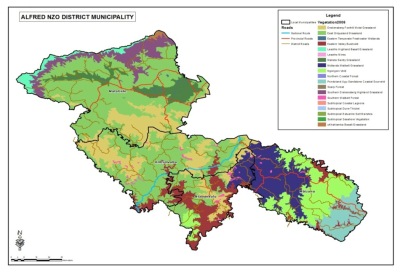About us
Executive Summary
Alfred Nzo District Municipality is located on the north-eastern side of the Province of the Eastern Cape and stretches from the Drakensberg Mountains, borders Lesotho in the North, Sisonke District Municipality in the East and O.R. Tambo District Municipality in the South. In preparation for the 2011 Local Government Elections, the Demarcation Board in terms of the Demarcation Act of 2008 as amended declared the changes in some municipalities (inter-boundaries) where some local municipalities were to be moved from the other district municipalities to the other and also the amendment of municipal wards boundaries. Through that Alfred Nzo District Municipality is one of the affected district municipalities where it was declared that two Local Municipalities from O.R. Tambo District Municipality being Mbizana and Ntabankulu will be incorporated under Alfred Nzo District Municipality in the process. Circular No. 54 of the Municipal Finance Management Act No. 56 0f 2003, gives guidance in terms of preparations and adoption periods of Municipal IDPs and Budgets for 2011/12 considering the changes that will take place due to the Local Government Elections. In terms of the National Treasury, the affected municipalities by the Demarcation process when doing their planning in terms of Integrated Development Plans and Budget for 2011/12 should take into consideration the proposed changes as a result of the demarcation process. Circular 54 of the Municipal Finance Management Act of 2003 further gives options in terms of the time period for the municipalities to adopt their IDPs in preparation for the changes as a result of elections. The district municipality together with its local municipalities resolved to adopt Option 1 where both IDP and Budget will be adopted by the current Council and the new Council will have to endorse the adopted IDP and Budget by its predecessor.
The District surface area has increased due to incorporation of Mbizana and Ntabankulu Local Municipalities from 6858 to 11119 square kilometers and is now sub-divided into four local municipalities: Matatiele covering 4352 km² (39% coverage of district area), Umzimvubu 2506 km² (23% coverage of district area), Mbizana 2806 km² (25% coverage of district area) and Ntabankulu occupying 1455 km² (13% coverage of district area). The process also entailed the amendment of all four municipalities’ wards where the wards for Umzimvubu LM increased from 24 to 27 due to some wards from Ntabankulu Municipality being incorporated under Umzimvubu Local Municipality; Matatiele 24 to 26; Mbizana from 25 to 31 and Ntabankulu from 15 to 18 wards. The changes resulted in Alfred Nzo District Municipality being formed by a total of 102 wards.
Legislative Mandate
There is a multitude of policy and legislation that Municipalities must comply with and take cognisance of, the most important of which are the following;
- The Republic of South Africa Constitution Act (1996); Chapter 7 (Sec 153) sets out the objectives of Local Government and provides that Municipalities have a developmental duty which entails structuring and managing their budget, administration and planning processes in a manner that prioritizes the basic needs of their communities whilst promoting social and economic development within their communities. Chapter 3 deals with co-operative governance which is essential to the fulfillment of the objectives given that these objectives encompass a wider spectrum than the functional areas of Municipalities. Section 152 further mandates the municipalities to strive to achieve the following objectives:
a) To provide democratic and accountable government for local communities;
b) To ensure the provision of services to communities in a sustainable manner;
c) To promote a safe and healthy environment and;
d) To encourage the involvement of communities and community organizations in the matters of local government
- The Municipal Systems Act (2000); read together with the Municipal Planning and Performance Regulations (2001) provides the legislative framework for integrated development planning. Municipalities must undertake developmentally oriented planning and are legally required to adopt an IDP, give effect to their IDP, conduct their affairs in a manner consistent with their IDP and review their IDP on an annual basis.
- The Local Government Municipal Finance Management Act, (2003) requires municipalities to coordinate the process of preparing the annual budget and revising the IDP to ensure that there is integration between the two. It makes provision for Service Delivery Budget Implementation Plans (SDBIP) to ensure effective implementation of service delivery in accordance with the annual budget.
- Other pertinent legislative frameworks include the Municipal Structures Act, (1998) and the Inter-Governmental Relations Framework, (2005).
- Relevant policy frameworks include the RDP (1994), GEAR (1996), White Paper on Local Government (1998), PGDP (2004 -2015), Provincial Spatial Development Plan (2003) and the ECDLGTA Framework Guide for Credible IDP’s.
Our Vision
By 2030, Alfred Nzo will be a place where communities enjoy much improved public infrastructure in an environmentally sustainable manner, better quality of public services and socio-economic opportunities.
Our Mission
ANDM being a driver for change will ensure effective delivery of sustain-able services in an economic and efficient manner.

